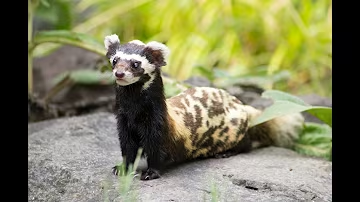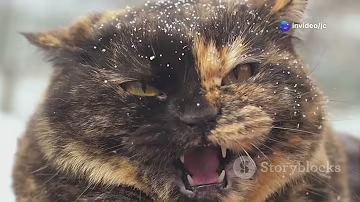
Marbled Polecat
Vormela peregusna

Meet the Marbled Polecat
The marbled polecat is a small, vividly patterned mustelid native to the grasslands and arid regions of Eurasia. Its striking fur displays a mix of yellow, brown, and black marbling on the back, with a contrasting white face marked by a dark mask. Marbled polecats are solitary, mostly nocturnal, and are known for their burrowing habits, often occupying abandoned rodent burrows. When threatened, they emit a pungent secretion from their anal glands to deter predators. Their populations are declining due to habitat loss and fragmentation.
Classification
Mammal
Habitat
Steppe and semi-desert grasslands
Diet
Carnivore
Lifespan
3-8 years
Conservation
Vulnerable
Weight
0.3–0.7 kg
📖Fascinating Facts
Colorful Warning
The marbled polecat's striking marbled fur acts as aposematic coloration, warning predators of its potent defensive spray.
Stinky Defense
When threatened, it releases a foul-smelling secretion from its anal glands, much like a skunk.
Burrow Dweller
Marbled polecats often take over the burrows of ground squirrels, gerbils, and other small mammals for shelter and hunting.
📋Detailed Description
The marbled polecat (Vormela peregusna) is a small, slender mustelid distinguished by its vividly patterned pelage. Adults typically measure 29–35 cm in body length, with a bushy tail adding another 14–20 cm; they weigh between 320 and 715 grams, with males generally larger than females. The fur on the back is yellowish with irregular dark brown or black blotches, while the underparts are pale, and the face is white with a prominent dark mask across the eyes. Ears are short and rounded, and the limbs are relatively short but strong, adapted for digging. The marbled polecat has sharp, curved claws and a flexible body, allowing it to pursue prey into burrows. It is primarily solitary and territorial, using scent marking to delineate its range. Primarily crepuscular and nocturnal, it spends the day in underground dens, often appropriated from rodents. Its diet is varied, consisting mainly of small mammals (especially ground squirrels, voles, and hamsters), birds, eggs, reptiles, and large insects. The marbled polecat is known for its defensive behavior: when threatened, it arches its back, raises its tail, and emits a pungent secretion from its anal glands. This species is adapted to arid and semi-arid environments, inhabiting steppes, semi-deserts, and open grasslands across southeastern Europe, the Middle East, Central Asia, and western China.
💡 Did you know?
The marbled polecat's defensive odor is so strong it can drive away much larger animals, including predators like wolves.
🔬Research & Sources
Wikipedia Summary
The marbled polecat is a small mammal belonging to the genus Vormela within the mustelid subfamily Ictonychinae. Vormela is from the German word Würmlein, which means "little worm". The specific name peregusna comes from perehuznya (перегузня), which is Ukrainian for "polecat". Marbled polecats are generally found in the drier areas and grasslands of southeastern Europe to western China. Like other members of the Ictonychinae, it can emit a strong-smelling secretion from anal sacs under the tail when threatened.
Last Modified: 5/4/2025
🎭Behavior & Social Structure
Marbled polecats are solitary and highly territorial, with home ranges that can span several square kilometers depending on prey availability. They are primarily active at dusk and during the night (crepuscular and nocturnal), though some diurnal activity has been observed in undisturbed areas. They are accomplished diggers, using both their own claws and abandoned burrows of rodents for shelter and hunting. Their hunting strategy involves stalking and rapid pursuit of prey within burrows, utilizing their slender bodies to navigate tight spaces. Marbled polecats are opportunistic feeders, occasionally caching excess food. Social interactions are limited outside the breeding season, with individuals communicating via scent marking, vocalizations (growls, hisses, and shrieks), and visual displays. When threatened, they perform a characteristic threat display, arching their backs and fluffing their tails before releasing their defensive scent.
👶Reproduction & Life Cycle
The breeding season for marbled polecats varies geographically but generally occurs from March to June. Males and females come together only for mating, after which the male departs. The species exhibits delayed implantation: after fertilization, the embryo remains dormant for several months, with active gestation lasting 30–40 days. Total gestation, including delay, can last up to 10 months. Litters typically consist of 4–8 kits, born blind and helpless in a well-lined den. The young open their eyes at around 38–40 days and are weaned by 50–54 days. Females provide all parental care, and juveniles disperse at about 2–3 months of age. Sexual maturity is reached at 10–12 months.
🛡️Adaptations & Survival
Marbled polecats possess several adaptations for their arid, open habitats. Their cryptic, marbled coat provides camouflage among grasses and rocky terrain. The slender, flexible body and strong claws are specialized for entering and navigating rodent burrows, both for hunting and shelter. Their anal scent glands produce a potent secretion that deters predators, a trait common in the Ictonychinae subfamily. They have acute hearing and olfactory senses for detecting prey underground. Physiologically, they are tolerant of temperature extremes and can survive with limited water, obtaining moisture from prey. Behavioral adaptations include food caching and seasonal shifts in activity patterns to avoid extreme heat.
🎨Cultural Significance
While not a major figure in folklore, the marbled polecat has been referenced in traditional cultures across its range, often associated with its striking appearance and strong odor. In some regions, it has been considered a pest due to predation on poultry, but it is also valued for its role in controlling rodent populations. Its pelt has occasionally been used in local fur trades, though not on a large scale. The species' unique coloration and defensive behaviors have made it a subject of curiosity in natural history collections and wildlife literature.
🔬Recent Research & Discoveries
Recent research has focused on the marbled polecat's population genetics, habitat use, and responses to landscape changes. Studies using camera traps and radio telemetry have provided insights into home range size, movement patterns, and habitat preferences, highlighting the importance of undisturbed steppe habitats. Genetic analyses have revealed significant population structuring, suggesting limited dispersal between fragmented populations. Ongoing research is investigating the impact of rodenticide exposure and secondary poisoning. Conservation programs in Kazakhstan and Uzbekistan are trialing habitat restoration and community-based monitoring. The species is also being studied as an indicator of steppe ecosystem health.
🎥Wildlife Videos

MarbledPolecat#WildlifeDocumentary#SurvivalInTheWild#MustelidFamily#NatureWonders#RareAnimals
Join us on a captivating journey into the world of one of Eurasia's most elusive and striking predators—the Marbled Polecat.
Learnfinity

Meet the Marbled Polecat: The Colorful, Brave, and Super Smelly Hunter!
Get ready to explore the wild world of the Marbled Polecat—a small, colorful creature with a bold personality! Known for its ...
Happy Learners and Minds

Ukrainian soldiers reclaim their bunker from a marbled polecat
Every day is the day to wake up and choose violence according to this cute critter.
RiffRaffMama

The Mysterious Marbled Polecat: Uzbekistan's Unique Mammal #cuteanimal #wildlife
The Mysterious Marbled Polecat: Uzbekistan's Unique Mammal Meet the marbled polecat, one of Uzbekistan's most fascinating ...
CuteAnimal_JC

5 Fun Facts About The Marbled Polecat
Music: Libre Musician: @iksonmusic.
Your5Facts

A Closer Look At The Fearless Night Hunters | Our World
This film follows the life of a Female Polecat for a year in the Welsh valleys, chronicling her violent courtship and subsequent ...
Our World
🌍Habitat Information
The Marbled Polecat typically inhabits Steppe and semi-desert grasslands environments. Marbled Polecats have adapted to their environments with specialized features and behaviors.
Primary Habitat:
Steppe and semi-desert grasslands
More detailed habitat information will be available soon.
🛡️Conservation Status
The Marbled Polecat is currently classified as Vulnerable. Conservation efforts are crucial for preserving this species for future generations.
Common Threats:
- 🏠Habitat loss and fragmentation
- 🌡️Climate change impacts
- 🎯Hunting and poaching
- 🏭Human-wildlife conflict
⚠️Threats & Conservation Challenges
The marbled polecat is classified as Vulnerable by the IUCN, with populations declining due to habitat loss, fragmentation, and degradation, primarily from agricultural expansion, overgrazing, and infrastructure development. Rodenticide use and widespread poisoning campaigns targeting ground squirrels and other rodents have led to secondary poisoning and reduced prey availability. Road mortality and illegal trapping for the fur trade also pose threats. The species is sensitive to disturbance and requires large, contiguous tracts of steppe or semi-desert habitat, making it particularly vulnerable to landscape changes. Population trends indicate a continuing decline across much of its range, with local extirpations reported in parts of Eastern Europe and Central Asia.
🔬Scientific Classification
Scientific Name
Vormela peregusna
Classification Hierarchy
🔍 About Taxonomic Classification
Taxonomic classification is a hierarchical system used by scientists to classify and organize living organisms based on shared characteristics and evolutionary relationships.
The system moves from broad categories (Kingdom) to increasingly specific ones, with each animal's scientific name typically consisting of its Genus and species.
📝Community Notes
Share your observations and insights about the Marbled Polecat with our community of wildlife enthusiasts.
Join Our Community
Sign in to share your observations and connect with fellow wildlife enthusiasts.
Sign In to ContributeNo community notes yet
Be the first to share your observations about the Marbled Polecat!
Explore Marbled Polecat
Select a tab above to learn more about this amazing animal.
📸Photo Gallery
No photos available for this animal yet.
🌟Discover More Wildlife
Continue your journey of discovery with more fascinating animals from our database
